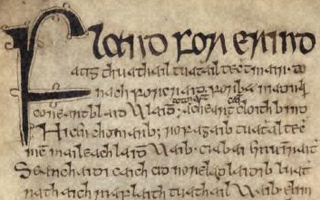Dubhaltach Mac Fhirbhisigh, also known as Dubhaltach Óg mac Giolla Íosa Mór mac Dubhaltach Mór Mac Fhirbhisigh, Duald Mac Firbis, Dudly Ferbisie, and Dualdus Firbissius was an Irish scribe, translator, historian and genealogist. He was one of the last traditionally trained Irish Gaelic scholars, and was a member of the Clan MacFhirbhisigh, a leading family of northern Connacht. His best-known work is the Leabhar na nGenealach, which was published in 2004 as The Great Book of Irish Genealogies, by Éamonn de Búrca, more than 300 years after it had been written.

The Great Book of Lecan or simply Book of Lecan is a late-medieval Irish manuscript written between 1397 and 1418 in Castle Forbes, Lecan, in the territory of Tír Fhíacrach, near modern Enniscrone, County Sligo. It is in the possession of the Royal Irish Academy. Nollaig Ó Muraile dated it to c. 1397–1432 or possibly even a little later. Another estimate dated it to the early 15th century.
Nollaig Ó Muraíle is an Irish scholar. He published an acclaimed edition of Dubhaltach Mac Fhirbhisigh's Leabhar na nGenealach in 2004. He was admitted to the Royal Irish Academy in 2009.
Seán Mór Ó Dubhagáin was an Irish Gaelic poet.
Leabhar na nGenealach is a massive genealogical collection written mainly in the years 1649 to 1650, at the college-house of St. Nicholas' Collegiate Church, Galway, by Dubhaltach MacFhirbhisigh. He continued to add material until at least 1666, five years before he was murdered in 1671. The original 17th century manuscript was bequeathed to University College Dublin (UCD), by Dublin solicitor Arthur Cox in 1929, and can be consulted in UCD Library Special Collections. The manuscript can be viewed online at Irish Script on Screen, which is available in English, and in Irish. Leabhar na nGenealach, was reprinted, and published in a five volume edition in Dublin in 2004 as The Great Book of Irish Genealogies.
Cuimre na nGenealach is an abridgment of Dubhaltach Mac Fhirbhisigh's Leabhar na nGenealach, written at his home in Lecan in Tír Fhíacrach Múaidhe, County Sligo in the spring and summer of 1666.
Ádhamh Cúisín, Irish scribe and genealogist, fl. c. 1400.
Cían d'Fhearaibh Bolg, last King of the Senchineoil of Magh Senchineoil, now in County Galway, Ireland.
Irish genealogy is the study of individuals and families who originated on the island of Ireland.
Aed Ua Dubhda King of Ui Fiachrach Muaidhe, died 983.
Muircheartach mac Pilib Ó Ceallaigh was Archbishop of Tuam in Ireland, and patron of the literary compilation An Leabhar Ua Maine. He was a son of Pilib Ó Ceallaigh, and a brother to William Buidhe Ó Cellaigh, King of Uí Maine and Chief of the Name.
Mael Ruanaidh Ua Dubhda, died 1005.
Tadhg Riabhach Ó Dubhda was King of Uí Fiachrach Muaidhe.
Dubda mac Connmhach, Eponym and Ancestor of the Clan Ó Dubhda of north Connacht, fl. 9th–10th century.
Ruaidhrí Mear Ua Dubhda was King of Ui Fiachrach Muaidhe.
Maol Ruanaidh mac Ruaidhrí Ó Dubhda, Chief of the Name and Lord of Tireragh, died c. 1450.
Éamonn mac An Cosnamhach Ó Dubhda was an Irish Chief of the Name and Lord of Tireragh who died c. 1471.
Connmhach mac Duinn Cothaid, King of Ui Fiachrach Muaidhe, died 787.
Ó Cobhthaigh is a Gaelic-Irish surname, generally anglicised as Coffey, Cofer, Coffer, Copher, Caughey, Coffee, Coffie, Coughey, Cauffey, Cauffy, Cauffie, Coffy, Coughay, Coffay, Coffeye, Couhig and many more.
Faolán Mac an Ghabhann na Scéal, died 1423, was an Irish writer and genealogist. He was one of the ten scribes of Leabhar Ua Maine, commissioned by Archbishop of Tuam, Muircertach Ó Ceallaigh. His poem, Adham ar n-athair uile is penned in the text by Ádhamh Cúisín. Nothing else seems to be known of him.
